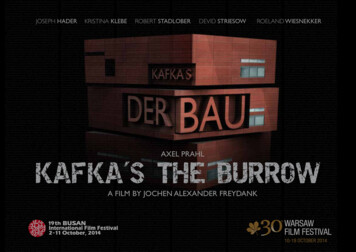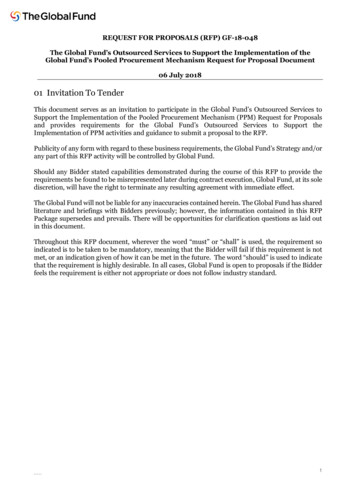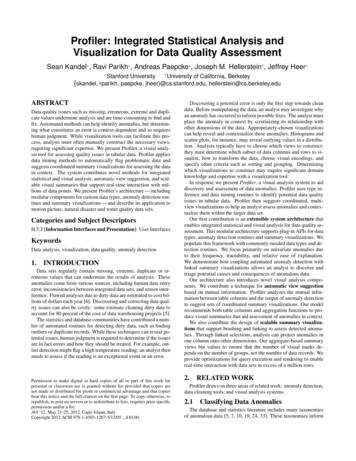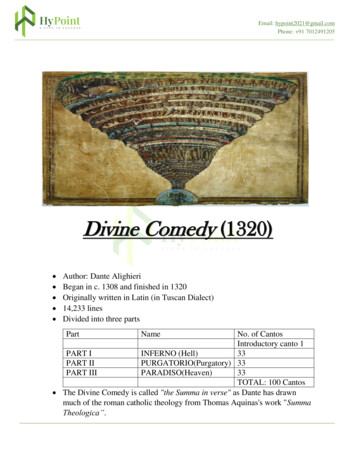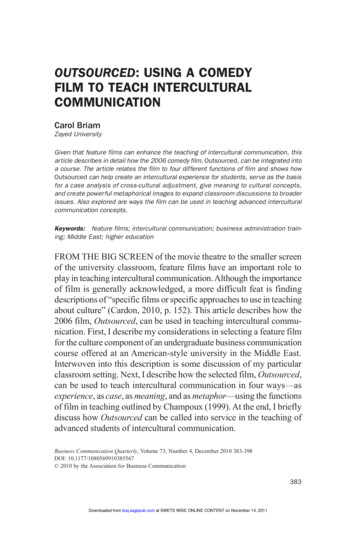
Transcription
OUTSOURCED: USING A COMEDYFILM TO TEACH INTERCULTURALCOMMUNICATIONCarol BriamZayed UniversityGiven that feature films can enhance the teaching of intercultural communication, thisarticle describes in detail how the 2006 comedy film, Outsourced, can be integrated intoa course. The article relates the film to four different functions of film and shows howOutsourced can help create an intercultural experience for students, serve as the basisfor a case analysis of cross-cultural adjustment, give meaning to cultural concepts,and create power ful metaphorical images to expand classroom discussions to broaderissues. Also explored are ways the film can be used in teaching advanced interculturalcommunication concepts.Keywords: feature films; intercultural communication; business administration training; Middle East; higher educationFROM THE BIG SCREEN of the movie theatre to the smaller screenof the university classroom, feature films have an important role toplay in teaching intercultural communication. Although the importanceof film is generally acknowledged, a more difficult feat is findingdescriptions of “specific films or specific approaches to use in teachingabout culture” (Cardon, 2010, p. 152). This article describes how the2006 film, Outsourced, can be used in teaching intercultural communication. First, I describe my considerations in selecting a feature filmfor the culture component of an undergraduate business communicationcourse offered at an American-style university in the Middle East.Interwoven into this description is some discussion of my particularclassroom setting. Next, I describe how the selected film, Outsourced,can be used to teach intercultural communication in four ways—asexperience, as case, as meaning, and as metaphor—using the functionsof film in teaching outlined by Champoux (1999). At the end, I brieflydiscuss how Outsourced can be called into service in the teaching ofadvanced students of intercultural communication.Business Communication Quarterly, Volume 73, Number 4, December 2010 383-398DOI: 10.1177/1080569910385567 2010 by the Association for Business Communication383Downloaded from bcq.sagepub.com at SWETS WISE ONLINE CONTENT on November 14, 2011
384BUSINESS COMMUNICATION QUARTERLY / December 2010CONSIDERATIONS IN SELECTING A FEATURE FILMOn the surface, it would seem that a multicultural setting such as Dubai,United Arab Emirates, would be an ideal location for teaching intercultural communication. After all, this country of more than eight million people is a bustling mixture of nationalities, and it has the highestnet migration rate in the world (United Arab Emirates, 2010). However,my students—young Emirati women—generally live somewhat sheltered lives and cultural practices work against their mingling withoutsiders. The result is that despite the multicultural nature of the cityand country where I teach, the students themselves tend to have limitedintercultural experiences that they bring to the classroom.During my first semester of teaching a business communicationcourse in Dubai, 3 weeks were devoted to intercultural communication.During those 3 weeks, I explained typical terms such as uncertaintyavoidance and low-context culture. I used the standard classroom exercises that accompany chapters on intercultural communication, suchas a “values questionnaire,” which asks us to consider, for example,who of three people should be asked to jump out of a sinking lifeboatto allow the remaining two people an opportunity to live. Answers tothis question can reveal, for example, to what extent a culture is orientedtoward youth or the elderly or to achievement or status. I also recountedvarious anecdotes about my experiences of living in eight diversecountries over the past 25 years. Although these stories perhaps intriguedor surprised students, they remained my stories—events I had livedthrough and whose context I knew well, a context that students couldnot begin to appreciate.Thus, a desire to add value to this component of the course was thedriving force for me to look for a film to incorporate into the classroom.My search was greatly aided by the Intercultural Film Database, anonline project of the University of Hildesheim’s Institute of Intercultural Communication in Germany. The project website dex.php) analyzes various filmsaccording to 20 cultural dimensions explained in a glossary on thewebsite. I developed a shortlist of films after browsing some of theanalyses. From this shortlist, I looked at trailers of the films availableonline through YouTube and the films’ producers, and then I selectedOutsourced. (A trailer for Outsourced is available at http://outsourcedthemovie.com/c intercultural.html.)Downloaded from bcq.sagepub.com at SWETS WISE ONLINE CONTENT on November 14, 2011
Briam / OUTSOURCED385Released in the United States in 2006 and directed by John Jeffcoat,Outsourced is a comedy about a Seattle call center manager namedTodd Anderson whose job, along with that of his staff, is outsourcedto India. To add insult to injury, Todd is sent to India to train his replacement. The film revolves around Todd’s culture shock in India, thefriendships and romance that develop, and the way he adjusts and isultimately changed by his experience in India.Although my criteria for selecting a film may not have been clearlyarticulated at the time I chose Outsourced, looking back I see thatseven considerations dominated my thinking. Namely, I was lookingfor a film that would:1. Demonstrate concepts. The whole point of using a film was to showexamples of cultural dimensions being discussed because, as Champoux(1999) argues, “film scenes can offer a visual portrayal of abstracttheories and concepts” (p. 206). Using a fictional film was also a convenient means of deflecting attention away from discussions focusedon local examples. In a setting where democracy is absent and wherereverential photos of the country’s rulers adorn billboards, usinglocal examples of “high power distance,” for instance, could be perceived as being critical or derogatory. Wanting to avoid such a situation, I found Outsourced to be an excellent choice. As Bisoux (2009)notes, “As a fictional comedy, it allows students to critique and discuss its content freely” (p. 44).2. Avoid simplistic cultural caricatures. Although an ideal film for teaching intercultural concepts “should provide several clear examples ofcontrasting values and the behavioral manifestations that result,” asMallinger and Rossy (2003) claim (p. 616), at the same time I wantedto avoid a type of “good guy–bad guy” dichotomy or a film rife withcultural stereotypes. After all, film should be used to teach “not onlythe broad concepts of culture but its complexities as well” (p. 613).Outsourced meets this criterion: The film’s “realistic, documentarylike portrayal provides students with a rich window into a global environment” (Bisoux, 2009, p. 44).3. Fit in with a culturally conservative environment. Much material usedin Western classrooms could be considered culturally offensive inMiddle Eastern classrooms. Outsourced has a PG rating and is generally acceptable, despite some mildly bad language and a few romancescenes. I ended up not showing certain parts of the film that couldoffend, such as a scene (quite tame by Western standards) where ToddAnderson and his romantic interest are in a hotel room together.Downloaded from bcq.sagepub.com at SWETS WISE ONLINE CONTENT on November 14, 2011
386BUSINESS COMMUNICATION QUARTERLY / December 20104. Have a connection to business. Since the course is part of the university’s core business curriculum, I wanted the film to have some type ofbusiness theme. The film’s title is evidence of its business thrust. TheNew York Times review of Outsourced also confirms that the film’sculture-clash story “could be taught in business schools” (Seitz, 2007,para. 11).5. Offer a connection to South Asian culture. South Asian workers makeup the largest expatriate group in the UAE (United Arab Emirates,2010) and their dominant presence here engenders a negative attitudetoward them by some Emiratis. To counter this tendency, I wanted afilm that featured South Asian personalities in a sympathetic waybecause film may be a critical component in developing empathy andcross-cultural sensitivity (Tidwell, 2001).6. Provide a cross-cultural experience. Given that many students’ movements are limited due to family or societal restrictions, firsthandcross-cultural experiences may be difficult to promote. A film such asOutsourced, which offers a realistic intercultural scenario, can be auseful substitute. As Champoux (1999) observes, “Inexperiencedstudents will likely benefit from the use of film because of a greaterfeeling of reality” (p. 206). “The unique qualities of film . . . can createstrong experiences for viewers” (p. 211).7. Entertain and motivate. I decided to show, over three class periods,most of the 103-minute film. Because much class time would bedevoted to the film, I wanted to make sure that I chose a film studentswould enjoy. Enjoyment and motivation to learn more about differentcultures can go hand in hand. Cardon (2010) notes that “one of theprimary benefits, particularly among university students, is that filmsare entertaining, engaging, and in many cases stimulate curiositytoward other cultures” (p. 151).USING OUTSOURCED IN TEACHINGINTERCULTURAL COMMUNICATIONIn discussing ways that film can be used in teaching, Champoux (1999)cites four functions that are explored here: as experience (creating anexperience for viewers), as case (providing a nonprint case to be analyzed), as meaning (giving meaning to theories and concepts), and asmetaphor (creating metaphorical images of abstract concepts). I willdiscuss how Outsourced can be used as a basis for each of these functions in teaching.Downloaded from bcq.sagepub.com at SWETS WISE ONLINE CONTENT on November 14, 2011
Briam / OUTSOURCED387ExperienceUsing film as experience, instructors of intercultural communicationcan rely on Outsourced to introduce students to Indian culture byshowing certain customs and behavior in the country. From the momentthe protagonist, Todd Anderson, arrives in India (Bombay and laterGharapuri), the viewer lives through the new experiences that Toddconfronts. The film’s visual detail and soundtrack featuring Indianstyle music combine to transport the viewer to Todd’s new world. Onarrival, Todd faces a chaotic transportation system, having to jumponto a crowded moving train, and later chasing after his suitcase whichis thrown into a small auto-rickshaw, or as Todd calls it, “one of thosetaxi go-cart thingies.” He immediately observes different customs,beginning with a man urinating by the side of the road and continuingto the street boy who pesters him and later snatches his cell phone. Atthe ragtag building that has been built to house the call center whereTodd will work, a cow appears in one of the offices in one comic scenewhere Todd stands flabbergasted, while his Indian counterpart (Puro)remains unfazed by the cow’s presence.Different food, language, and marriage practices are especiallyprominent in the film. In the realm of food, Todd eats gola from astreet vendor, and his subsequent stomach problems become fodderfor future comic scenes. When he is offered a snack at the guest housewhere he stays, Todd makes the cultural faux pas of eating with hisleft hand, considered the unclean “toilet” hand in many parts of theworld. At one point, feeling obvious pangs of homesickness, Toddcraves a cheeseburger and travels to Bombay by taxi to visit what hethinks will be a McDonald’s, only to find out that he has arrived at animitation fast food restaurant that serves only “maharajah veggie burgers” and the like.Numerous language differences are highlighted in the film, beginning with names. Everyone Todd meets—much to his frustration—endsup calling him “Mr. Toad.” Todd, in turn, comically fumbles the nameshe encounters. For example, when his Indian replacement, Puro,announces that he plans to marry a woman named BhagyashreeSasamunde, Todd questions: “Baggy who?” Later, when Puro explainsto Todd about the Indian festival day of Holi, which celebrates colorand the changing of seasons, Todd quizzically inquires: “Holy what?”Downloaded from bcq.sagepub.com at SWETS WISE ONLINE CONTENT on November 14, 2011
388BUSINESS COMMUNICATION QUARTERLY / December 2010Todd quickly discovers that the slang terms he casually uses areunfamiliar to others. In one scene at the beginning of the film, Purocomments about how impressive Todd’s business card is—ExecutiveVice-President of Marketing and Order Fulfillment for Western Novelty.Before Todd realizes that Puro will be the replacement that he is totrain, he replies: “Not as impressive as it sounds. What I really do issell kitsch to rednecks and now I have to train some other schmuck todo it.” To this, Puro politely responds: “Would you kindly be tellingme what is kitsch, and what is redneck, and what is schmuck?The training of Indian call center representatives to deal with American customers highlights other language differences. One call centerworker replies to a grandmother’s inquiry about school supplies forher grandson’s first day of school by suggesting: “Perhaps some rubbers, ma’am?” This example engenders a chain of misunderstandings.Todd says that “eraser” should be used instead of “rubber,” explainingthat “a rubber means condom.” “Oh, you mean like a flat,” chimes inone worker, to which Puro offers: “No, they call it an apartment.”Marriage practices discussed in the film play a big role in Todd’sexperience of discovering India. At one point, Todd is incredulouswhen he discovers that an Indian woman he becomes romanticallyinvolved with (Asha) has been engaged since the age of 4 as part ofan arranged marriage by her parents. Puro’s pending marriage alsoreveals different cultural considerations in the setting of a weddingdate. When Puro faces the prospect of losing his job, he is sure thatBhagyashree’s parents will have her marry someone else right away.“What’s the hurry?” inquires Todd, to which Puro replies: “Astrology.Her moons are lined up. Auspicious time. She must marry this year.”Witnessing the numerous situations Todd faces in adjusting to Indiaprovides a rich intercultural experience for student viewers, even ifthat new culture is experienced vicariously.CaseOutsourced can be used as a basis for a case analysis of cross-culturaladjustment. Todd’s initial encounters with his staff at the Gharapuricall center are especially valuable as material to be examined bystudents. Todd acts in an ethnocentric manner at the beginning. In onescene, he chastises his Indian employees, saying: “The center’s numbersDownloaded from bcq.sagepub.com at SWETS WISE ONLINE CONTENT on November 14, 2011
Briam / OUTSOURCED389are nowhere near what they should be, and based on the customercomplaints we’ve been having, it’s a culture thing. Basically, you peopleneed to learn about America.” Ignoring the fact that the workers arenative English speakers, albeit with a different accent, Todd admonishesthem: “Basically you people need to learn about America. . . . Thingsgo faster if the customer feels they are talking to a native Englishspeaker.” Concluding the session, Todd reminds the workers onceagain: “Learn about America. You want to sound American.”In one particularly revealing scene, Todd displays his ignoranceabout Indian culture and the Hindu religion by discussing one of thecompany’s novelty products: a burger brand (a type of branding ironfor steaks and meat). Responding to a question from one of the callcenter workers about the purpose of the product, Todd increasinglyrepulses his audience as he discusses cattle branding practices inAmerica. The scene culminates with Asha, who is a call center worker,advising him: “You need to learn about India.”Todd’s transformation in becoming more comfortable with Indianculture and open to discovery about the culture provides a potentiallyinteresting case study to examine specific ways in which a person canease adjustment to a new culture. The turning point for Todd’s transformation apparently begins when a compatriot he meets at the quasiMcDonald’s indicates that he too felt frustrated when he first arrived:“I was resisting India. Once I gave in, I did much better.” Some timeafter that conversation, Todd admits to his staff that he has made amistake in trying to run the Indian call center like an American office.He asks for, and implements, suggestions for improving the work environment. In a subsequent fun-filled work session at the call center, Toddgood-naturedly obliges a request from a worker to do a dance from anIndian movie.Even during his most ethnocentric phase, Todd remains a likeablecharacter. The fact that he endears himself to the movie viewer fromthe beginning perhaps adds to his value as a subject for a case study.Meaning“Film is an excellent medium for giving meaning to theories and concepts,” according to Champoux (1999, p. 211). Outsourced is particularly well suited to give meaning to intercultural concepts. For my class,Downloaded from bcq.sagepub.com at SWETS WISE ONLINE CONTENT on November 14, 2011
390BUSINESS COMMUNICATION QUARTERLY / December 2010I relied on five sets of commonly used cultural dimensions featured inAdler and Elmhorst’s (2008) textbook Communicating at Work. In fact,before viewing the film, students were given a table containing theterms with space to jot down notes about scenes from the film thatdemonstrated particular cultural dimensions. The sets of terms mirrorin large part the predominant framework set forth by Geert Hofstede(1980) in his seminal study of international work values.Below I provide a brief explanation of each of the five sets of fundamental dimensions of cultural diversity from the Adler and Elmhorst textbook (low-context and high-context culture, individualism and collectivism,low power distance and high power distance, uncertainty tolerance anduncertainty avoidance, and task orientation and social orientation), alongwith examples from the film that represent each of the dimensions.Low-Context Culture and High-Context CultureA low-context culture “uses language primarily to express thoughts,feelings, and ideas as clearly and logically as possible . . . The meaning of a statement is in the words spoken” (Adler & Elmhorst, 2008,p. 47). A high-context culture, on the other hand, “relies heavily onsubtle, often nonverbal cues to convey meaning, save face, and maintain social harmony. Communicators . . . discover meaning from thecontext in which a message is delivered” (p. 47).In the film, Todd has a straight-talking style that reflects a low-contextculture. For example, when Todd is first taken to the ramshackle buildingthat houses the call center in Gharapuri, he does not hide his reaction:“Oh, you gotta be kidding me. This is it?” he asks Puro. Similarly, Todddoes not hide his dissatisfaction with the call center’s high MPI, theaverage number of minutes per incident spent to resolve each call: “Whyis the MPI so bad?” he asks. “Puro, this place is a disaster.”In contrast, Todd’s Indian counterparts reflect a high-context culture.For example, when Todd asks Puro if he can take a long trip to recovera shipment that has been sent to the wrong location, Puro declines therequest in a very indirect manner, in line with collectivists’ concern formaintaining social harmony. “No problem,” he says. “But first I mustsleep for two hours, so that I can come back for the interviews withthe new agents, and then I must make sure that my mother gets to thehospital.”Downloaded from bcq.sagepub.com at SWETS WISE ONLINE CONTENT on November 14, 2011
Briam / OUTSOURCED391Individualism and CollectivismIndividualistic cultures “offer their members a great deal of freedom,the belief being that this freedom makes it possible for each personto achieve personal success” (Adler & Elmhorst, 2008, p. 48). Memberstend to “put their own interests and those of their immediate familyahead of social concerns” (p. 48). In contrast, members of collectivistcultures “have tight social frameworks in which members of a group. . . feel primary loyalty toward one another and the group to whichthey belong” (p. 48).Todd has his own apartment in Seattle, he lives alone, and he isambitious and consumption-oriented. As he explains to Puro: “In myworld, it just makes sense to work your ass off and go into credit carddebt just so you can have that 50-inch plasma.”Todd also does not see his parents often, even though they live only2 hours away from him. This news stuns Puro, who also cannot understand why Todd continues to work for a company and a boss he dislikes.Todd and Puro are at opposite ends of the individualism-collectivismcontinuum.A series of events at the beginning of the film also highlight thecontrast between individualist and collectivist cultures: When Todd sits down on a crowded train after a boy has given him hisseat, the boy unabashedly sits on Todd’s lap, much to the surprise ofTodd, who is used to the private personal space of a person from anindividualist culture. When Puro is taking Todd to his accommodations, Puro changes theplans for Todd to stay at the Gharapuri Palace Hotel. “That place is verylonely,” says Puro, in true collectivist manner. “I’ll take you to AuntieJi’s guest house. She will take care of you better than your own realmother.” When individualist Todd protests that he would prefer to goto his hotel, Puro insists: “We go to Aunti Ji’s. . . . You’ll not be lonelythere.” Finally, when Todd arrives at Aunti Ji’s, this is the first question she, asa collectivist, asks: “So, Mr. Toad. What does your father do?”Interactions between Todd and Asha also highlight the contrastbetween members of individualist and collectivist cultures. When Toddasks Asha if she would ever consider living in the United States, sheDownloaded from bcq.sagepub.com at SWETS WISE ONLINE CONTENT on November 14, 2011
392BUSINESS COMMUNICATION QUARTERLY / December 2010says: “I would miss my parents; it would be too hard.” When they arein public together, Asha is concerned what others will think. Todd, onthe other hand, cannot understand this preoccupation. “You’re a freewoman!” he exclaims. Then when he hears the news that her parentshave arranged her marriage since she was a child, he can not believethat a smart, opinionated woman like her would accept this. “Whatabout your right to choose for yourself?” he asks.Low Power Distance and High Power DistanceCultures with low power distance “downplay differences in power”(Adler & Elmhorst, 2008, p. 50) and its members are comfortableapproaching or challenging superiors. Cultures with high power distanceaccept an unequal distribution of power and the fact that “some members have greater resources and influence than others” (p. 50).The low power distance characteristic associated with Americanculture is revealed in the totally uninhibited way in which Todd speaksto his boss, Dave. On different occasions, Todd calls Dave a “corporateslime-ball” and a “cheap bastard.” Todd’s demonstration of low powerdistance contrasts with the deferential way in which his Indian employees address him, using Mr. Todd and Sir.Uncertainty Tolerance and Uncertainty AvoidanceCultures that tolerate uncertainty are more comfortable with unpredictability and risk taking, and they are “relatively tolerant of behaviorthat differs from the norm” (Adler & Elmhorst, 2008, p. 50). Culturesthat avoid uncertainty “are less comfortable with change. They valuetradition and formal rules, and show less tolerance for different ideas”(p. 50).In Outsourced, Asha refers to practices in India that are characteristicof uncertainty avoidance: “A girl in my position has her whole life mappedout in front of her.” Asha explains that her father is an assistant managerin a phone company and that her mother comes from a small village.Asha said that as she was always being told: “Asha, you can’t go touniversity” or “Asha, you can’t work in a call center—what will peoplesay?” According to Asha, “Everything I’ve done I’ve had to fight for.”In a significant moment for Asha, Todd shows her that people canchange their “inherited” roles. Representing a culture that toleratesDownloaded from bcq.sagepub.com at SWETS WISE ONLINE CONTENT on November 14, 2011
Briam / OUTSOURCED393uncertainty, Todd promotes her to assistant manager, saying he believesthat “Asha can do anything.” Those words are magical for Asha. “Ialways wanted to believe that, but until you, I didn’t think it was true,”she tells Todd.Task Orientation and Social OrientationTask-oriented cultures focus on making its members “more competentthrough training and use of up-to-date methods and are highly concerned with individual success” (Adler & Elmhorst, 2008, p. 51).Cultures with high social orientation “focus more on collective concerns” such as cooperative problem solving and maintaining a friendlyatmosphere (p. 51).In Outsourced, the continued pressure to achieve a lower MPI ratingreflects the task orientation of Todd’s and Dave’s culture. Puro, on theother hand, represents a social orientation when, early on, concernedabout Todd’s unwell appearance from eating gola, he abandons his jobresponsibilities to go find food that will help Todd’s stomach.Using a conceptual framework such as cultural dimensions, backedup by specific examples from a film such as Outsourced, helps studentsto see general differences among cultures. But, as Mallinger and Rossy(2003) note, film is useful when it goes beyond the broad concepts ofculture to encompass “its complexities as well, especially the ambiguities and paradoxes that characterize the subtleties of interactions amongindividuals from different cultures” (p. 613). Here again, Outsourceddoes not disappoint. Here is a brief summary of ways characters in thefilm display cultural dimensions not usually associated with their nativecultures: Individualism and collectivism: At the end of the film, the first phonecall Todd makes when he arrives home in Seattle is to his parents. Hisexperience in India has changed him, and this phone call is one manifestation of that change. Low power distance and high power distance: Indian call center workers begin to address Todd by his first name. Uncertainty tolerance and uncertainty avoidance: In the midst oftradition-bound India, Todd’s Indian neighbors who live on the otherside of the wall of the guest house demonstrate an extreme ability toadapt to difficulties and to find creative solutions to problem. Thus, asterling example of uncertainty tolerance exists within a culture proneDownloaded from bcq.sagepub.com at SWETS WISE ONLINE CONTENT on November 14, 2011
394BUSINESS COMMUNICATION QUARTERLY / December 2010to uncertainty avoidance. Todd himself is inspired by these neighborswhen he takes action to restore electricity to the call center after flooding. Task orientation and social orientation: Although Todd is the task master at the beginning of his tenure in India, he later veers toward a moresocial orientation, by asking his Indian employees: “What would makeyour work day a more positive experience?” For their part, the Indianemployees become more task oriented as they respond to an incentiveprogram that rewards MPI improvement by giving them access to company merchandise.In sum, Outsourced provides a rich backdrop for exploring the meaning of intercultural concepts, in terms of broad generalities as well asaccompanying complexities.MetaphorFilms can create powerful metaphors, which “often leave lasting impressions that a person easily recalls” (Champoux, 1999, p. 210). One canfind a number of metaphors in Outsourced that merit discussing, suchas the reference in the film to the bindi Asha wears on her forehead, oras she explains: “the eye with which you see the most important things.”The film also makes repeated reference to Kali, the Goddess of Destruction. Explains Asha: “She ends one cycle so a new one can begin.”Two metaphors in the film are especially poignant. One metaphorin the film is the wall between rich and the poor. This metaphor appearsin the form of the wall that separates the comfortable guest house whereTodd stays from the spartan shacks on the other side. At one point,Todd dares to breach the wall and discovers that the people he meetson the other side of the wall are—despite their poverty—dignified,proud, and extremely resourceful. Scant dialog occurs during the scenewhere Todd, obviously moved, shares a meal with a family on the otherside of the wall. It is one of the most memorable scenes of the film.Another powerful metaphor is the “(Call) Fulfillment” building thatserves as the call center headquarters in India. The word fulfilment(with British spelling) is etched onto the front of the building. Thatimage can be a metaphor for what the company means to the peoplewho work there. For Todd, he makes the decision to walk away fromthe materialism that motivated him before in order to seek another typeof fulfillment. For the Indian workers, on the other hand, the fulfillmentDownloaded from bcq.sagepub.com at SWETS WISE ONLINE CONTENT on November 14, 2011
Briam / OUTSOURCED395center represents a step up to middle-class living standards and theability to purchase the “kitsch” products that Todd so despises.Because metaphors can prod the imagination and offer a new wayto experience facts (Champoux, 1999), their presence in this film canhelp stimulate discussion about broader themes related to the film.USING OUTSOURCED TO TEACH ADVANCEDINTERCULTURAL COMMUNICATIONThe well-traveled or culturally savvy student may at times find thecharacters in Outsourced to be a bit stereotypical or the dialog somewhatglib. Such students may also find that classro
Briam / OUTSOURCED 385 Released in the United States in 2006 and directed by John Jeffcoat, Outsourced is a comedy about a Seattle call center manager named Todd Anderson whose job, along with that of his staff, is outsourced to India. To add insult to injury, Todd is sent to India to train his replace-ment.

